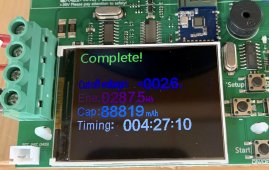Some of these load testers use IRFP240A MOSFET for load device. Some have the IRFP250A or their Chinese clones.
The recent Atorch DL24 I bought has the better IRFP260A device.
Depending on device used, the Rds_ON of MOSFET will limit their minimum pull down voltage at 20 amps from 2.0v to 3.6v.
Add a little extra for PCB runners and connector terminal, before you get to your wiring loss.
When loading MOSFET gets hot its Rds_ON rises, by about 130% of room temp at 65 degs C making min pull down voltage higher.
Should avoid IRFP240A
IRFP240A -> Rds_ON at 25degs C = 0.14 ohms, x 20 A = 2.8v + PCB drop + connector drop + wire drop.
IRFP240A -> Rds_ON at 65degs C = 0.18 ohms, x 20 A = 3.6v + PCB drop + connector drop + wire drop.
Satisfactory results with IRFP250A, if wiring drop is not too great
IRFP250A -> Rds_ON at 25degs C = 0.08 ohms, x 20 A = 1.6v + PCB drop + connector drop + wire drop.
IRFP250A -> Rds_ON at 65degs C = 0.10 ohms, x 20 A = 2.0v + PCB drop + connector drop + wire drop.
----------------------------------------------------------------------------------------------------------------------------
Best replacement device, maintaining 200v max breakdown.
IRFP260A -> Rds_ON at 25degs C = 0.04 ohms, x 20 A = 0.8v + PCB drop + connector drop + wire drop.
IRFP260A -> Rds_ON at 65degs C = 0.05 ohms, x 20 A = 1.0v + PCB drop + connector drop + wire drop.
If the device cannot make the terminate discharge voltage you set with 20 amp load it will continue to discharge battery until cell current drops off enough for the voltage across the Rds_ON to make your terminate trip voltage. This will not be the intended discharge point on cell you want.




